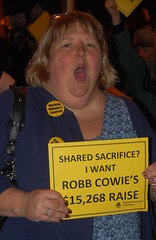PPS and the philanthro-capitalists
November 30, 2009
Sheila Wilcox had a problem. She was teaching eighth grade at a newly expanded elementary school, its first year with eighth grade. The building did not have adequate physical space for the middle grades, and the staff had almost no training or advice on teaching a self-contained middle grade class within an elementary school.
This was in 2008-09 school year, a year after Carole Smith, the newly hired superintendent, had formed a “K-8 Action Team,” and several months after that team had held a public meeting. Wilcox went to the team’s Web page and found somebody at the district office to e-mail.
Wilcox said she wrote to Sara Allan, listed as the project manager for the K-8 team, and told her: “I’m stuck out in a portable, I have no computers, I have no books, I’m teaching eighth grade.”
It took a week to get a response, said Wilcox, and she got no answers to her specific questions. She was told the district was trying to work with the K-8 schools to get the best programs in place. But there was nobody from the district working with teachers at her school, and she didn’t know who else to call.
Wilcox had also noticed that the K-8 team’s Web site listed courses her school had never offered and had no plans to offer. When she notified the district, they said it was data from the previous year, and it would be updated. It never was.
Sara Allan led the K-8 action team, along with two senior administrators: Joan Miller, a part-time retired administrator; and Harriet Adair, a full-time area director, supervising principals at several schools. The team held a series of community meetings in the 2007-2008 school year, and claimed to address some serious issues like libraries, algebra and science labs. The team showed competence in things like middle grade scheduling, but never fully accounted for the actual deficiencies of existing K-8 schools, or presented any real analysis of the scope and depth of the K-8 problem.
After a May 2008 community meeting, the K-8 Action Team went quiet. No more meetings were held, and no announcements made.
K-8s hadn’t stopped being a crisis in the community, but they seemed to have dropped off the district’s radar.
How did we get here?
The root of this problem was the rushed addition of middle grades to most elementary schools in the district, a process phased in over the previous three school years with virtually no planning or sense of a unified model. Principals were going it alone with no district support. Some middle schools were also converted, with the addition of primary grades. These schools managed the change relatively well, at least for middle grade students, since there were, in many cases, enough students to continue funding a comprehensive middle school program.
But most of the elementary schools that converted to K-8s have continued to fare poorly, many with largely self-contained classrooms and few, if any, electives. And as it happened, these “ele-middles” (as coined by parent Lakeitha Elliot) are concentrated in poor and minority neighborhoods.
Middle schools were preserved in some parts of Portland. Eight of the district’s 10 remaining middle schools — Beaumont, da Vinci, Hosford, Jackson, Mt. Tabor, Robert Gray, Sellwood and West Sylvan — are located in majority white high school clusters (Cleveland, Franklin, Grant, Lincoln and Wilson). A total of two, George and Lane, remain in the district’s four majority non-white attendance clusters (Jefferson, Madison, Marshall and Roosevelt).
PPS claims they have not tracked the demographics of middle grade students assigned to and attending K-8 schools, compared to middle schools. (I requested this demographic information from Public Information Officer Matt Shelby, and Sarah Carlin Ames, Director of Government Affairs. Shelby wrote in e-mail that the district is unable to fulfill my request.)
But it is clear, extrapolating from available data showing middle schools to be disproportionately white and non-poor when compared to the general PPS student population, that middle grade students at K-8 schools are conversely poor and non-white.
Deputy Superintendent Charles Hopson recently told the City Club of Portland that “based on race and zip code roughly 85% of white students have access to opportunity in rigorous college prep programs, curriculum and resources compared to 27% of black students.” Even without the direct, hard data from the district, we can see the same is true about access to comprehensive middle school programs.
The largest stretch between middle schools in Portland is the eight and a half miles between George middle school in North Portland and Beaumont in Northeast. This stretch spans historically poor and working class neighborhoods, and includes all of historically black Portland.
Org chart changes
With the new school year in 2009, the district announced major org chart changes, including a promotion for Sara Allan, to “Senior Director of Planning and Performance Management,” reporting directly to Carole Smith and supervising a senior management team (three with the title of Director, plus two “Advisor[s] to the Superintendent” and three “Senior Managers”) in charge of everything from high school redesign to data and policy analysis. Harriet Adair, once an assistant superintendent, is now listed as an “Advisor to the Superintendent” on K-8 redesign, reporting to Allan.
Other than Adair, who also advises the superintendent on early childhood issues, it appears the K-8 Action Team no longer exists in any significant, working form.
Its Web page is no longer prominently linked on the district Web site, which has since undergone a redesign. But the page still existed as of publication of this article, listing these objectives to be completed by August 2008:
- Work to identify critical operational supports for PK-8 schools in the 2008-09 year and develop strategies to fill gaps in the following areas.
- Staffing
- Enhancements to facilities
- Professional development for teachers
- Student support
- Design a common districtwide PK-8 model and set of guidelines for grades 6-8 education and define a plan to build the required elements over the next three years.
- Create a process to engage schools and the community in the vision and the plan.
It’s unclear if any of this work has been completed more than a year after its targeted completion. Allan said the team continues to exist, albeit without any dedicated, full-time staff.
“There’s lots of ongoing planning around how do we continue to make sure that all of our 6-8 programs are very comparable in terms of what opportunities students have,” said Allan. “They’re constrained by the resources that we have available, but there’s definitely ongoing work around insuring that we have consistent programs in all places so that kids are equally prepared for high school.”
Allan also said there is “a lot of work going on analyzing how we do staffing allocations.” Despite this work, K-8s continue to operate on the same staffing allocation as middle schools, which, with their much larger student cohorts, are able to offer dramatically more curriculum for the same money per student.
Just under half of the district’s middle grade students currently have access to a traditional middle school in their neighborhood. Would it make sense to go back to a middle school model for the entire district, or at least make sure that all students have access to a nearby middle school?
“I think the question is, is the structure of the middle school the answer, or is it what’s happening in the classrooms?” said Allan.
She said that by bringing middle grade student populations up to a minimum of 150 students, and with adjustments to the staffing formula, all middle grade students can have access to the same kind of education, regardless of the configuration of their school. That means the district will have to shift funding from middle schools, or “equalize down”, in order to provide even a basic middle grade experience in the K-8 schools.
Under the current funding formula, 150 students provide enough budget for about six teachers for the middle grades, enough to basically do self-contained classrooms. Astor, where Wilcox teaches, has around that number of students.
With an adjusted staffing formula, would there be any way to pay for electives like instrumental music and world languages for every K-8 school?
“That is the stuff we’re looking at specifically,” said Allan.
Rebecca Levison doesn’t buy it. She’s a teacher with experience in a self-contained middle grade classroom, and the current president of the Portland Association of Teachers, the union representing the district’s teachers.
There is no way, Levison contends, that the district’s K-8 schools will offer anything close to what is currently offered in middle schools.
The district’s K-8 strategy centers on retaining and building middle grade enrollment up to 150 students. That, combined with an adjusted staffing formula, appears to be the extent of planning to deal with a problem that is well into its fourth year.
It’s not clear if there is any plan to have an adjusted staffing formula in place, or to increase enrollment for the 2010-11 school year, the fifth year of K-8 implementation.
Choice and equity
Over the years, as the district has experimented with a market-oriented, competition-based student enrollment system, schools in poor and minority neighborhoods lost significant enrollment, funding, and curriculum. Jefferson High School, Oregon’s only majority black high school, had an attendance area population of just over 1,500 in fall of 2008. Approximately 500 high school students enrolled that year, with nearly 1,000 transferring out under the district’s liberal school choice policies.
Then, as now, Jefferson’s course catalog reflected this loss of enrollment and funding. At the former arts magnet school, there were no music classes offered, no advanced placement classes, no chemistry, physics, or calculus, and no world languages other than Spanish.
The district has had no real strategy for dealing with this self-reinforcing spiral of declining enrollment and opportunity brought on by allowing students to freely transfer from one neighborhood school to another. Disproportionately non-white and poor schools like Jefferson were told they had to increase enrollment in order to replace lost courses. But without a reasonable course catalog, these schools didn’t have much in the way of recruitment tools.
Vicki Phillips, who preceded Carole Smith as superintendent, promoted school choice as a tool for equity in spite of overwhelming evidence of the damage it did to schools in poor and minority neighborhoods. Smith’s plan for high schools tacitly acknowledges the failure of this policy.
Under Smith, the district has announced a high school plan that would bring comprehensive schools to all, and significantly do away with the market-based strategy of choice and competition for enrollment pushed under Phillips, at least for high schools.
The plan would implement a high school system based on neighborhood enrollment, with student transfers restricted to guarantee similar school sizes and funding. This would also ameliorate the significant self-segregation that has resulted in schools more segregated today than thirty years ago.
Every student, or so the plan says, will have access to comprehensive neighborhood high schools of about the same size and with the same range of programming, including courses for college credit, instrumental music, choral music or dance, and a choice of world languages. This would be a major upgrade for schools in our poorest neighborhoods, and represents an important acknowledgment of a basic economic reality.
The free market approach to enrollment and funding is a demonstrable failure in Portland, when measured by access to educational opportunity. Unless the district is willing to significantly reduce opportunity for the white middle class, there’s no way they can pay for equity of opportunity without balancing enrollment, that is, by curtailing school choice. This is a significant element of the high school plan. With it, the district appears to be forging a path independent of current trends pushed by Gates, at least for high schools.
But the district appears unwilling to apply the same lesson to middle grades.
Sara Allan’s contention that it’s not the structure of the school that matters, but what goes on in the classroom, also closely parrots the current line being sold by Phillips, now head of education for the Bill and Melinda Gates Foundation.
Phillips was the keynote speaker at the Council of The Great City Schools conference held in Portland last month, attended by Allan and quite a few of her administrative colleagues. In her speech, Phillips promoted merit pay for teachers, the latest policy thrust of Gates.
While superintendent in Portland, Philips was responsible for both the transition to K-8 schools and the “small schools” initiative, funded largely by the Gates foundation, which dismantled every comprehensive high school in Portland serving majority non-white students, and split them into rigid “academies.” These academies forced students to choose a narrow field of study as freshmen, and didn’t allow students to take electives offered in other academies in the same building.
When combined with Phillips’ dogmatic fealty to school choice, comprehensive secondary education was thus eliminated for the majority of poor and minority students in Portland. Students who are white and wealthier are statistically more likely to take advantage of student transfers, so schools re-segregated even as attendance areas reintegrated and gentrified. With funding following students, and with rules in place to allow wealthy families to directly fund public schools in their neighborhoods, access to comprehensive secondary education was preserved for the majority of white students in Portland, even while it was eliminated for everybody else.
To date, we seem stuck with this legacy of Vicki Phillips, despite some positive talk about equity of opportunity: We continue to have a clearly defined two-tiered education system, particularly in the secondary grades, with ZIP code, race and class primary determinants of access to a broad-based secondary education.
Gates’ quiet partner
The Bill and Melinda Gates Foundation has grown to be the dominant voice in the national education dialogue, heavily influencing the federal education policy of both George W. Bush and Barack Obama. But even as PPS appears to be taking a non-Gates path on high schools, the district continues to be enamored with Gates’ biggest private-sector education policy ally: Eli Broad’s education foundation.
In 2003, the Broad Foundation started a residency program to lure management professionals into the field of public education. Founded by real estate magnate Eli Broad in the 1960’s, the foundation’s mission is “to advance entrepreneurship for the public good in education, science and the arts.”
The Broad Residency in Urban Education promises young MBAs with as little as four years’ work experience a package that might otherwise take a career to attain: a full-time, senior-level management position in a large urban school district (or charter management organization), reporting to the superintendent or top executive, and a salary of $85,000 – $95,000.
For two years, Broad pays half the residents’ salaries. The school district picks up the other half, plus the cost of benefits. After two years, the district is expected to keep the residents in their jobs, or promote them, picking up the full tab for their salaries.
Over the course of these two years, Broad flies its residents to eight quarterly trainings held at various locations around the country. Residents study topics like “Accountability and empowerment of schools,” “Influence using formal and informal authority” and “Initiating and sustaining large-scale change initiatives.”
The Broad Foundation, whose motto is “Transforming urban K-12 public education through better governance, management, labor relations and competition,” makes no bones about its support of charter schools and its desire to weaken teachers’ unions.
This ideology is couched in rhetoric about “student achievement,” especially among minority students, but Eli Broad himself is clear about his goals. Despite studies showing no improvement for students in charter schools, Broad’s strategy relies strongly on promoting them. Broad spoke at the Michigan Governor’s Education Summit in 2004.
“We believe that healthy competition has raised the quality of higher education in the U.S. and can do the same for our K-12 public school system,” said Broad. “Michigan is to be congratulated for being one of our nation’s leaders in providing parents with competitive education alternatives, through public charter schools.”
Also at the top of Broad’s agenda is eliminating seniority for teachers, and instituting merit pay, or, in today’s parlance “pay for performance.”
“Many labor unions have become obstructionist in holding teachers accountable for student performance,” Broad told his Michigan Audience. “We have to start compensating teachers on a performance basis rather than on seniority. I know that some unions don’t like to hear that, but introducing true accountability is essential to ensuring that student performance improves.”
This amounts to blaming teachers for the overwhelming effects of poverty in the lives of students.
“Student performance,” entirely measured by standardized test scores, correlates highly to poverty. Broad’s scheme would almost certainly assure that teachers in poor and minority communities would make less than their colleagues in wealthier schools, only worsening the achievement gap. This puts the lie to Broad’s (and Gates’) stated mission of closing that gap.
This kind of disconnect between Broad’s stated vision and his policy thrust hasn’t deterred Portland, a strongly blue collar town with high public support for organized labor, from welcoming Broad into its main school district.
Portland Public Schools has hosted four Broad Residents. One left after his residency, one is still in her residency, and two hold key strategic leadership roles overseeing the future of our schools.
Sarah Singer came to PPS five years out of graduate school in 2007, and led the high school system redesign planning over the past year or so (newly-hired Chief Academic Officer Xavier Botana appears to now be taking a more prominent role). Singer has two Masters’ degrees, but no prior professional experience in K-12 education. She makes $90,000 a year. (Top of scale for a teacher, with a PhD and twelve years’ experience, is around $70,000.)
The other is Sara Allan, who came to PPS as a Broad Resident in 2005, and worked at first in human resources and as a project manager. The K-8 Action Team was her first high-profile project. As an executive director she currently works part-time (80 percent) and is paid $90,000 a year. Her base salary of $112,500 is twice what many teachers make with an equivalent level of education. She never worked in a school or school district prior to joining PPS, and has no professional training in K-12 education.
District: No Broad Influence on Policy
Despite the Broad Foundation’s overt ideological thrust, Allan insists that Broad is not trying to push it on PPS.
“It’s really not just ‘bring corporate America to the schools’ at all,” said Allan. “It’s really very much a nuanced thing.”
Second-term school board member David Wynde agrees. He and his school board colleagues attended a Broad-sponsored retreat for in Los Angeles in 2003, in which Eli Broad addressed the attendees.
“There was no advocacy about policy content,” said Wynde. “They weren’t pushing a particular policy agenda. What they were pushing was [school] boards learning how to govern and what it meant to be an effective board, which is a good thing.”
Chief of Staff Zeke Smith acknowledges Broad’s political positions. “It would be silly of me to say that Broad doesn’t have any sort of ideological perspective in what they do,” he said, but he discounts that influence in PPS.
“I think they have an agenda in terms of putting people in a district and wanting to see innovation and change in those districts,” said Smith. “I think that’s why they’re bringing business leaders, but I think that’s also why they’re fairly open about what it is that you get. But I don’t think they’re prescriptive about what that is.”
Smith said the people PPS has hired out of Broad’s program bring “significant experience with project management, and that’s not necessarily a capacity that is well-developed inside of districts. So what we’ve gotten from that is people who understand how you take kind of large complicated issues that need a lot of different stakeholders — internal or external or both — to be involved, and put together a process whereby you can actually get to some real action steps and do it with some level of integrity.”
But can’t people with an education background manage complicated issues?
“Most people who work inside of a school district all the way up to the top have made their way to those positions from an education background,” said Smith, “and people value the idea that, ‘Hey, I was a teacher, then moved up the ranks to assistant principal, and then a principal, and then into administration,’ and there’s a lot of skills that they develop in those places; there’s a lot of skills that they’re exposed to through their classical academic training. Project management isn’t necessarily one of those.”
Smith also said it’s not just the corporate philanthropists pushing charters and merit pay. “We’ve actually got people inside of the White House and inside the administration who are probably going to push us more on those discussions and conversations than Broad has,” he said.
Indeed, the policy positions of Broad and Gates have been broadly adopted by the Obama Administration under Secretary of Education Arne Duncan. The Race To The Top Initiative promises $4.35 billion to states, so long as they are amenable to merit pay and charter school expansion.
Broad’s foundation has maintained close ties to national policy makers of both political parties; its board of directors is a who’s-who of “reformers,” cozy with the current administration and its predecessors, who mainly tout charter schools and merit pay as salves for what they call “the education crisis.” The bipartisan board is chaired by New York City Public Schools Chancellor Joel Klein and includes former Cabinet Secretaries from George W. Bush (Margaret Spellings) and Bill Clinton (Henry Cisneros). Washington D.C. schools Chancellor Michelle Rhee, well-known for her extreme merit pay programs, also serves on the board, as does Richard Barth, President and CEO of the KIPP foundation, a nationwide charter management organization with 82 charter schools, and Wendy Kopp, CEO of Teach for America, an organization that brings non-certified teachers to poor and minority schools.
A major thrust of the Broad Residency is the need for better management in the central office of school districts. Most district offices, it goes without saying, are full of former teachers in administrative roles. Teachers, Broad seems to think, can barely be trusted in the classroom, and they certainly aren’t qualified to be promoted into positions in control of large amounts of money.
Broad’s recruiting material spells it out: “Many school districts are the size of Fortune 500 companies. They need leaders and strong managers who understand the complex operations of a large organization—successful professionals with experience in human resources, operations, finance, strategic planning and other critical business areas.”
In Portland, one teacher, who prefers to remain anonymous, claims she overheard former Broad Resident Sarah Singer joke that being “education free” was a major qualification for leading education system redesign. (Singer denies having said this.)
The Teacher’s Union
Teachers and PAT are currently deadlocked over terms of a new contract to replace the one that expired in 2008. The two-year contract they are currently negotiating will expire in seven months, assuming they reach an agreement by then. A key sticking point is the district asking for more hours and more scheduling flexibility from teachers, while refusing to budge on salary.
“We’ve had a lot of formal conversations,” said Levison, the teachers’ union president, “and there has been absolutely no movement on their side. You can’t ask to increase somebody’s work day while simultaneously cutting their salary.”
Levison was surprised to encounter former Broad Resident Allan at the bargaining table, and questioned her qualifications.
“I don’t think you’re qualified for school administration if you haven’t been in the classroom,” said Levison. “Someone who is working in education needs to have background and experience, otherwise they’re making decisions at the 30,000 foot level.”
Allan acknowledges she is “part of the bargaining team, providing background analysis,” and defends her lack of educaton experience. “The key role my department plays is more about project management, organizing a process rather than trying to know the answer,” she said.
Allan said her role is more one of process rather than policy. “It’s a diverse group of people that are on the bargaining team that all are contributing,” she said, “and so I might be playing a role of packaging and presenting.”
But Levison sees a pattern in the current administration of making decisions that do not take into account the realities faced by teachers, students and families. She cites the scheduling of several school days this year with two-hour late openings, a top-down decision made without input from the district’s scheduling committee, as another example.
“They don’t understand how it impacts teachers’ workloads, how it impacts students, and how it impacts parents,” said Levison.
Teachers are accustomed to tough-on-labor negotiating from the district, but it especially stings coming from a young MBA with no background in the field making a base salary 60 percent higher than the most senior, most qualified teacher in the district.
“There’s a level of anger when teachers are working harder than ever, and they see Broad scholars and senior managers getting raises,” said Levison. “It increases the anger.”
While the superintendent’s office claims the district’s recent central office reorganization cut more than 10 administrative positions worth a million dollars, Levison disputes their figures. She says there is a tendency to create positions for displaced administrators rather than laying them off.
While several “area director” positions were eliminated, none of the administrators were let go or faced pay cuts in their new roles, even with reduced responsibilities. Harriet Adair was an area director last school year, directly supervising principals at several schools. Adair now has no staff directly reporting to her, according to Zeke Smith.
A teacher, speaking on condition of anonymity, said the joke in the schools is that “they put so-and-so in the basement of BESC sorting paper clips.”
When teachers demonstrated en masse at a recent school board meeting, they made an issue of the $15,268 raise administrator Robb Cowie got when he was promoted to Executive Director of Community Involvement and Public Affairs under the reorganization. The presence of highly-paid Broad staff at the bargaining table has further poured salt in the wound.
“I think there’s absolutely more they can cut,” said Levison. “None of these cuts are going to fill the hole, but when a Broad resident is making whatever they make, that’s an art teacher. That’s a music teacher. That’s a special ed teacher. That’s a special ed teacher and a para-educator.”
Levison is particularly irked at the way the district has dropped the ball on K-8 schools. “To ignore this huge disparity in K-8s and move on to high schools is just criminal,” she said.
Accountability: only for teachers?
While corporate philanthropists tout the importance of teacher accountability for student achievement, there doesn’t seem to be much accountability for their own failed reform efforts.
A commonly voiced perception in the community and in schools is that the K-8 model is a failure and that the K-8 Action Team has gone dormant. I asked Allan, now the person in charge of performance management for the district, how she would rate the performance of the K-8 Action Team.
“We’ve done a fairly lousy job,” she said, “in continuing to kind of engage with the community around this so they know what we’re doing, and they’re seeing it. I think we’re not necessarily hearing from them in terms of the same heightened level of concern as the K-8s have kind of matured a little bit, but that certainly doesn’t take the responsibility off us not to be doing a better job at engaging. So I would give us a bad grade on that.”
She claims some success with the K-8 model, and says there is no plan to go back to the middle school model that has been preserved in the wealthiest Portland neighborhoods.
“We don’t want to throw the baby out with the bath water,” Allan said.
“We’ve just been doing a big study on how’s student achievement doing at the K-8s versus the old middle schools, and there’s definitely some really good early indicators there in terms of closing the achievement gap,” said Allan. “We’re starting to see that some of our best results are coming out of K-8 schools.”
But this claim of K-8 success seems dubious, with the district unable to account for the demographics of middle grade students attending K-8 schools and with persistent and marked differences in the level of education on offer.
At Astor K-8 school, Wilcox said she and her colleagues had their break room converted to a classroom this year due to lack of space, a violation of their contract. Eighth grade continues to be taught in self-contained classrooms in portables on the playground, and there is still little in the way of central support for teachers.
Meanwhile, district leaders, fresh from Broad, assure teachers everything is under control in K-8 schools and demand more teacher flexibility in contract negotiations.
Pay no attention to the men behind the philanthro-capitalist curtain, their anti-teacher ideology and their solid track record of gutting public education for poor and minority students in Portland. This is education “reform,” and it’s all about closing the achievement gap.
Steve Rawley published PPS Equity from 2008 to 2010, when he moved his family out of the district.










